
The western skink is a species of small, smooth-scaled lizard with relatively small limbs. It measures about 100 to 210 mm in total length. It is one of seven species of lizards in Canada. They spend much of their day basking in the sun. Their diet ranges widely, including spiders and beetles. Western skinks will bite if grasped and will flee if they feel threatened. It is a common but secretive species whose range extends from southern British Columbia and throughout Washington, Oregon, Nevada, Utah, Idaho, and Wyoming and into western Montana and northern Arizona and Missouri. They can also live in some areas of Texas It is widespread in northern California but primarily restricted to the coast in central and southern California. Found in a variety of habitats, this lizard is most common in early successional stages or open areas of late successional stages. Heavy brush and densely forested areas are generally avoided. Western skinks are found from sea level to at least 2,130 m (7,000 ft). This diurnal reptile is active during the warm seasons.

Plestiodon anthracinus, the coal skink, is a species of lizard which is endemic to the United States.

Plestiodon gilberti, commonly known as Gilbert's skink, is a species of heavy-bodied medium-sized lizard in the family Scincidae. The species is endemic to the southwestern United States and northwestern Mexico, and grows to about 7 to 12 cm in total length.
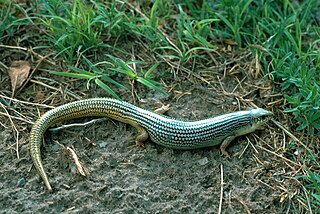
The Great Plains skink is a species of lizard endemic to North America.

The prairie skink is a species of skink endemic to the prairies east of the Rocky Mountains in North America. It is one of only seven species of lizards that occur in Canada.

The (American) five-lined skink is a species of lizard in the family Scincidae. The species is endemic to North America. It is one of the most common lizards in the eastern U.S. and one of the seven native species of lizards in Canada.

Plestiodon inexpectatus, the southeastern five-lined skink is a common skink in the southeastern United States.
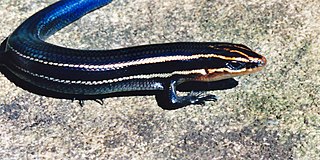
The four-lined skink is a species of lizard, which is endemic to North America. It is a medium-sized member of the Plestiodon skinks.
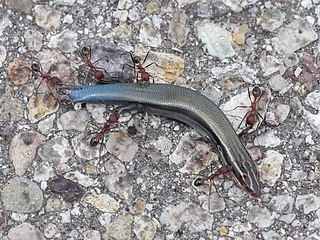
Plestiodon callicephalus, commonly known as the mountain skink, is a species of lizard, a medium-sized member of the Plestiodon skinks, endemic to North America.

Plestiodon multivirgatus, commonly known as the many-lined skink, the northern many-lined skink, or the variable skink, is a medium-sized species of lizard, a member of the North American skink genus Plestiodon in the family Scincidae. The species is native to the western United States.

The Bermuda skink, longnose skink, or Bermuda rock lizard is a critically endangered species and the only endemic land-living vertebrate of Bermuda. It is a relatively small skink : adults reach an average snout-to-vent length of about 8 cm (3.1 in).

Kishinoue's giant skink, also known as the Japanese skink, is a species of skink, a lizard in the family Scincidae, endemic to the southern Ryukyu Islands of Japan.

Scincella gemmingeri, commonly known as the forest ground skink, Cope's forest ground skink, and la escíncela de bosque de Cope in Mexican Spanish, is a species of lizard in the family Scincidae. The species is endemic to Mexico.
Cryptoblepharus pannosus, also known commonly as the ragged snake-eyed skink, is a species of lizard in the family Scincidae. The species is endemic to Australia.
Plestiodon bilineatus, also known as the Mexican shortnose skink, or the two-lined short-nosed skink, is a species of lizard endemic to Mexico.
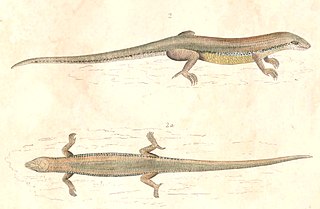
Plestiodon chinensis, the Chinese blue-tailed skink, is a species of lizard which is found in China, western Taiwan, and northern Vietnam.

Plestiodon dicei, or Dice's short-nosed skink, is a species of lizard which is endemic to Mexico. It was named in honor of Lee R. Dice, who collected the holotype in 1930 while conducting a faunal survey in the Sierra de San Carlos, Tamaulipas, Mexico. It was considered a subspecies of Plestiodon brevirostris for many decades. Plestiodon dicei occurs in northeastern Mexico, in the Sierra Madre Oriental in Coahuila, Nuevo Leon, San Luis Potosi, and Tamaulipas, with isolated populations in the Sierra de San Carlos and the Sierra de Tamaulipas.
Plestiodon indubitus, the Mexican short-nosed skink, is a species of skink. It is endemic to Mexico and is known from the states of Guerrero, Morelos, Michoacán, and Jalisco. However, its relationships with other species formerly considered subspecies of Plestiodon brevirostris are not fully resolved.

Plestiodon japonicus is a species of lizard which is endemic to Japan. The IUCN lists the species as least concern.
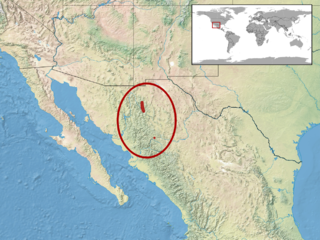
Plestiodon multilineatus, the Chihuahuan skink, is a species of skink. It is endemic to the state of Chihuahua, Mexico.


















